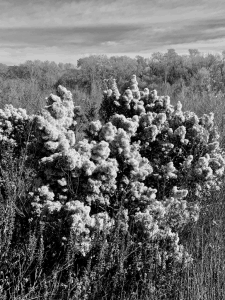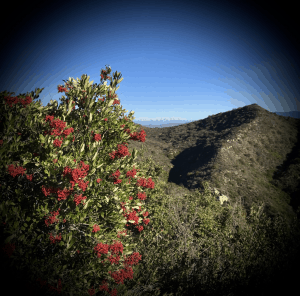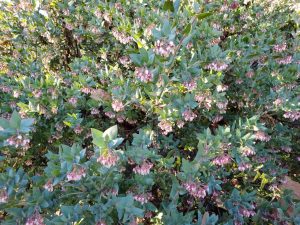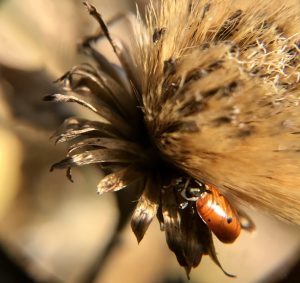January In the Natural Garden 2020
- Posted in: Blog, Monthly Garden Advice
- Tags Seasonal Gardening
Happy New Year Everyone! Will 2020 be the year of perfect vision? Let’s make sure we try to make it the best ever!
I missed posting this monthly piece in both November and December 2019, Sorry about that. Back at the drawing board now. All’s well here and I hope everyone is doing great.
~~~~~
Winter Solstice 2019
Winter solstice time, again
This one had been a clear day.
The light and the shadows
Expressing themselves in extreme terms.
The sun set a while ago
Below a waxing crescent moon with Venus so close
The two conversed at just a whisper.
Long cold night ahead.
When the air is quite this clear
You can see as far as there is anything to see
Mountains and islands and other landmarks.
You utter their names into the silence.
Cuyamaca, Palomar, Otay,
San Jacinto, San Gorgonio, San Antonio,
Catalina, San Clemente,
Not to mention our coastal beacons Mount Soledad, Dana Point, Palos Verdes
A tremendous accomplishment, again
With no less than zero effort,
Native plants that have grown or maybe only endured
Heat and cold, wind and calm, light and dark
For a year, and at last this season comes rain, again.
They use repeating cycles and long days
To sustain life, push out a few leaves, and make flowers in warmer times.
They set their seeds in the cold time of solstice.
Countless fluffy seed heads shine bright, reflecting winter’s light
The sun’s summer work being perfected now in metallic sheen
Black shadows seek deeply nested caverns inside dark branches
Where winter can show off its power.
 Coyote brush
Coyote brush
Like quartz crystals displayed on black velvet
Blow-away seed clusters atop common shrubs.
A study in contrast for the keen-eyed artist
And in perpetuation for the observant naturalist
Winterfat (Eurotia lanata), mulefat (Baccharis salicifolia),
Coyote brush (Baccharis pilularis ssp. consanguinea), and saltbush (Atriplex canescens),
Whose tiny dry seeds attach to parasols, feathers, and wings,
To be launched towards distant haunts on wintry-crisp winds.
Not to mention our conspicuous toyon (Heteromeles arbutifolia)
Luscious red berries… a real “red’s red” red, if you know what I mean,
Surrounding little stony seeds that could never go air-borne
Except being carried in a songbird’s gut.
Mike Evans 12/28/19
 Toyon
Toyon
~~~~~
So far, the winter 2019/20 season has provided relatively mild temperatures (no hard freezes at TOLN to date), generous rains (7.58” to date) and many crystal clear days when we know for sure why we love southern California. After last year’s rain totals of nearly 24” (about twice the average amount) we are on track to see one of the most stunning spring seasons ever. Stay tuned.
 Watering
Watering
If you have an automatic sprinkler system for watering your natural garden, it should be turned to OFF by now and with a little luck, you can leave it off a few more months.
When we claim that good native plant gardens require about 20-30% of the irrigation water used in most non-native ornamental plantings (yes, that’s a 70-80% savings!), it is true.
Related to Watering
The most efficient garden spaces include swales and basins, and all forms of microtopography to detain rainfall and surface water long enough for it to soak into the ground rather than running off to the storm drain. If you have room in your existing garden, scratch in a few berms and basins in order to treat rainwater as follows: slow it down, spread it out, soak it in.
Pruning
Very little pruning is necessary this month unless you missed thinning and shaping a few plants last fall. One new project though… Matilija poppy. If you have a mature stand of Romneya, now is the time to cut every stem off at a few inches above ground level. This is what gardeners call “cutting it off at the ground.” It will resprout grow and in May, bloom profusely.
Weeding
The first winter weeds may be making their debut appearance. If you know they are in fact weeds and not wildflower seedlings from your fall sowing, you can apply a layer of topdress, organic or mineral, to cover (and hopefully smother) the little seedlings, starve them of sunlight and thereby take care of the problem the easy way. But hurry. If they get too big or grow a strong root, they will still survive through the top dressing.
Mulching/Topdress
Needed only for weed control, see above.
Feeding
January is typically a little early to think about using fertilizer, but if you are seeing yellowing leaves or other signs of nutrient deficiency, you can apply some dry form organic fertilizer to individual plants or your whole garden as follows: First, follow the instructions on the bag regarding the rate. Next, blend the fertilizer with a little fresh organic mulch in a wheelbarrow or bucket. Scratch up the top 1/2” of soil using a 3-prong cultivator. Apply the blend approximately 1/2” thick. Lightly water to settle the blend onto the soil surface.
If you have no signs that the plants are lacking fertilizer at this time, you should wait about 6 weeks to apply the fertilizer as outlined above. More on this to come in February and March editions.
Troubleshooting – Varmints, Pests, and Diseases
Root rot and other fungal diseases caused by improper water management are never problems in winter. Native plants are adapted to cool moist soils, so rainfall, however copious, rarely causes problems underground, unless you have a plant sitting in sopping wet soil for many days on end. The cause of root rot is most often lack of oxygen in the root zone, usually in warm soils of summer. Let the rainwater your plants this season… all’s well.
Many insect pests are active all year. In your sustainable garden, natural predators (insects, birds, lizards, etc.) will help keep a balance. Try to control Argentine ants as they can be the cause of other problems including scale, mealybug, aphid, etc. If the outbreak of harmful insects is severe, consider insecticidal soap, insecticidal oil, or other organic control measures. Contact us if you have questions.
Snails, slugs, webworms, and other caterpillars can cause chewing, rasping or lacing type damage on leaves. Usually you can control these pests by improving cultural practices, especially since many of them live their lives safely out of sight in the organic “mulch” that may be covering your ground. Bunnies might eat plants down to the nub; Elmer Fudd never really finished the job.
Annual Wildflowers
It is time to sow seeds now. The sowing season actually started about 6 weeks ago. If you sowed wildflower seed already, now try to distinguish between desirable seedling wildflowers and perchance weeds. Good luck with that. When you’re sure, you can pull the weeds.
Sow seeds now if you haven’t done so already.
Adding New Plants
This cool rainy season is the best time to plant natives. Come on over to Tree of Life. We have a warm fire in the fireplace (good place for it) a good dog (@dakota_the_nursery_dog), great people, decent coffee, and wonderful native plants for you and your garden.
Engage
The short days of winter make for some fantastic exploring. The long duration in our sunrises and sunsets, because of the sun’s angle in relation to the horizon, makes for some amazing moments in the pre-dawn quiet and the serenity of early evening. Fantastic extended shadows, even at midday are distinct. Our seasonally chilly temperatures, clean brisk winds, periods of rain, and winter skies with such amazing cloud parades present good reasons to slow down and work on that New Year’s resolution: Spend more time playing outdoors.
From the Garden,
Mike Evans
Questions? Help is just one call or one email away. Call (949) 728-0685 or email (with pictures if you like) our special helpline: gardenhelp@californianativeplants.com
To get our monthly updates sign up for our eNewsletter at this link here.

